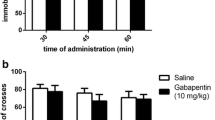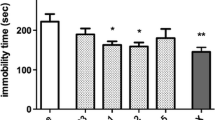Abstract
Rationale: There is some strong evidence about the role of nitric oxide (NO) as an intercellular messenger in central physiological mechanisms. NO is synthesized from l-arginine by nitric oxide synthase (NOS), as a response to activation of N-methyl-d-aspartate (NMDA) receptors by excitatory amino acids. NMDA receptor antagonists also produce antidepressant-like actions in preclinical models. Objective: In the present study, the involvement of NO in the mechanism of depression was investigated. 7-Nitroindazole (7-NI) (15, 30, 60, 90 mg/kg IP), a selective inhibitor of neuronal NOS was examined. Methods: The Porsolt forced swimming test (FST) has been used as a test for screening new antidepressant agents. Results: 7-NI dose-dependently decreased the immobility time in FST, but produced no significant change in locomotor activity in naive rats. Neither l-arginine, nor d-arginine (100 mg/kg) affected the immobility time in the FST or revealed any effect on locomotion. l-Arginine but not d-arginine, given 10 min before 7-NI, reversed the 7-NI-induced effect on immobility time. Conclusion: Our findings suggest that NO might be an important modulator of depression in rats.
Similar content being viewed by others
Author information
Authors and Affiliations
Additional information
Received: 3 June 1999 / Final version: 30 September 1999
Rights and permissions
About this article
Cite this article
Yildiz, F., Erden, B., Ulak, G. et al. Antidepressant-like effect of 7-nitroindazole in the forced swimming test in rats. Psychopharmacology 149, 41–44 (2000). https://doi.org/10.1007/s002139900316
Issue Date:
DOI: https://doi.org/10.1007/s002139900316




